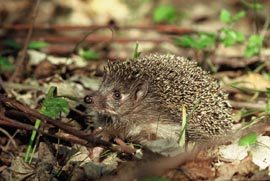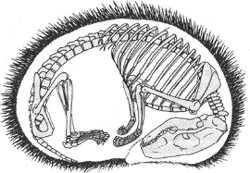Hedgehogs are unmistakable because of their spines. The spiny coat which protects him from many enemies, covers his back completely from forehead to tail and goes all the way down his flanks to his abdominal fur. When he senses danger, a hedgehog who has been happily snuffling around can, in seconds, roll up into an impenetrable ball of prickles.
Adult spines measure 2-3 cm, at birth they are less than one centimetre long. The diameter of the spines in the adult coat is about 2 mm. Spines renew themselves from the tip, they are embedded in the skin by a rounded basal bulb which is surrounded by muscles. Each spine is hollow. The internal walls are about 0.5 mm thick and strengthened with transverse septa. Therefore the structure is rigid but very light. In addition the material is flexible and rarely breaks. This stable structure can be life-saving: hedgehogs can cushion their fall from some height.
The spines have beige and brown stripes. In the wild this offers excellent camouflage. During the course of a hedgehog’s life, the spiny coat lightens and becomes gingery, the dark stripes become paler.
The needle-sharp spines sit in the dermal musculature. Each spine is moved, laid flat or bristled by its own erector muscle.

There are three generations of spines in all. Hoglets are born with about 100 spines. These are formed shortly before birth. They remain beneath the skin which is swollen with bodily fluid, so that the mother is not injured during the birth. A few hours after birth the tips of the first little spines emerge. They are white and quite soft at first.
After about 4 or 5 days a few pigmented spines start to sprout; the white spines gradually fall out. Second generation spines are somewhat shorter than the adult spiny coat, but are similar in all other respects.
Adult spines begin to emerge from 2-4 weeks of age, dark striped spines, which replace the juvenile spines. The longevity of a hedgehog spine is at least 18 months. Adult hedgehogs lose spines once in a while, which then re-grow.
The number of spines increases rapidly as the hedgehog grows: In addition to the 100 infant spines at birth, up to 300 spines grow within the first ten days of life. A hoglet weighing 43 grammes already has about 2000 spines, and a newly independent juvenile around 3500. Adult animals have about 8000 spines.

The spines of a foraging or sleeping hedgehog are relaxed and lie close to the body. If the hedgehog feels directly threatened, he tenses the thousand tiny muscles which surround each of his spines, and the spiny coat bristles up. Contraction of the dermal musculature causes this reaction.
The spines on the forehead are always the first to be pulled down like a visor over the eyes. If in danger, or when touched, hedgehogs can roll up as fast as lightning and so protect their whole body. They can roll up in less than a single second. The legs are tucked into the body, and the hedgehog rolls into a prickly ball with his orbicularis muscle
When the hedgehog is rolled up, his spines bristle in all directions. Whether he is rolled up to protect himself against danger or during hibernation, his defences are almost unassailable. A hedgehog can remain rolled up motionless for several hours, and during hibernation even for weeks.




